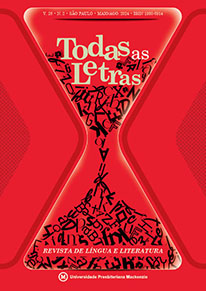Inteligência artificial e enunciação:
análise de grandes coleções de imagens e geração automática via Midjourney
Keywords:
Big Visual data, Enunciação, Geração automática de imagens, Inteligência ArtificialDownloads
References
BENVENISTE, É. Problems in general linguistics. Miami: University of Miami Press, 1971.
BEYAERT-GESLIN, A. Sémiotique du portrait: De Dibutade au selfie. Louvain-la-Neuve: De Boeck Supérieur, 2017.
COLAS-BLAISE, M. Comment penser la narrativité dans l’image fixe? La “composition cinétique” chez Paul Klee. Pratiques, n. 181-182, p. 1-15, 2019. Disponível em: http://journals.openedition.org/pratiques/6097. http://journals.openedition.org/pratiques/6097. Acesso em: jun.2024.
DONDERO, M. G. The semiotics of design in media visualization: mereology and observation strategies. Information Design Journal, v. 23, n. 2, p. 208-218, 2017. DOI: https://doi.org/10.1075/idj.23.2.09don.
DONDERO, M. G. Le travail des algorithmes. Quelques réflexions sur l’actantialité et l’énonciation. In: CONFERÊNCIA DA AFS, 10 jun. 2019a. Lyon, Université de Lyon 2, org. Pierluigi BASSO. Disponível em: https://core.ac.uk/outputs/220155468/. Acesso em: jun. 2024.
DONDERO, M. G. Visual semiotics and automatic analysis of images from the Cultural Analytics Lab: how can quantitative and qualitative analysis be combined? Semiotica, v. 230, p. 121-142, 2019b. DOI: https://doi.org/10.1515/ sem-2018-0104.
DONDERO, M. G. The language of images. The forms and the forces. Cham:
Springer, 2020.
DONDERO, M. G. Emerging faces: the figure-ground relation from renaissance painting to deepfakes. In: LEONE, M. (org.). The hybrid face: paradoxes of the visage in the digital era. London: Routledge, 2023. p. 74-86.
DONDERO, M. G. The face: between background, enunciative temporality and status. Reti, Saperi, Linguaggi: The Italian Journal of Cognitive Sciences, 1, a. 13 (25), p. 49-70, 2024.
DONDERO, M. G. Semiótica da inteligência artificial: análise computacional de grandes bases de dados e geração automática de imagens. Matrizes, 2025.
ECO, U. Semiotica e filosofía del linguaggio. Torino: Einaudi, 1984.
FOCILLON, H. Vie de formes. Paris: Presses Universitaires de France, 1934.
FONTANILLE, J. Les espaces subjectifs. Introduction à la sémiotique de l’observateur. Paris: Hachette, 1989.
FONTANILLE, J. Sémiotique et littérature. Essais de méthode. Paris: Presses Universitaires de France, 1998.
FONTANILLE, J. Sémiotique du discours. Limoges: Presses Universitaires de Limoges, 1999.
FONTANILLE, J. Semiótica do discurso. Tradução Jean Cristtus Portela. São Paulo: Contexto, 2015.
GOODMAN, N. Languages of art: an approach to a theory of symbols. Indianapolis: Hackett Publishing Company, 1976.
GREIMAS, A.J. Sémiotique figurative et sémiotique plastique. Actes sémiotiques.
Document VI, 1984.
GREIMAS, A. J. Du sens II. Paris: Seuil, 1983.
GROUPE μ. L’effet de temporalité dans les images fixes. Texte, n. 21-22, p. 41-69,1998.
KEMENY, J. G.; KURTZ, T. E. Introduction to Basic: programming language. New York: Wiley, 1964.
KERNIGHAN, B. W.; PLAUGER, P. J. Elements of programming style. 2. ed. New York: McGraw-Hill, 1978.
KNUTH, D. E. The TeXbook. Reading: Addison-Wesley, 1984.
LASSÈGUE, J. Turing. Tradução Guilherme J. F. Teixeira. São Paulo: Estação
Liberdade, 2017.
LIEN, J. The Basic handbook. New York: McGraw-Hill, 1981.
LOPES, C. V. Exercises in programming styles. Boca Raton: CRC Press, 2014.
MANOVICH, L. Cultural analytics. Cambridge: MIT Press, 2020.
MANOVICH, L.; ARIELLI, M. Artificial aesthetics: generative AI, art and visual media. 2021-2024. Disponível em: http://manovich.net/index.php/projects/artificial-aest hetics. Acesso em: jan. 2024.
MARIN, L. De la représentation. Paris: Seuil, 1993.
PETITOT, J. Morphologie et esthétique. Paris: Maisonneuve et Larose, 2004.
QUENEAU, R. Exercises in style. Paris: Gallimard, 1947.
TANAKA-ISHII, K. Semiotics of programming. Cambridge: Cambridge University Press, 2010.
THOM, R. Local et global dans l’oeuvre d’art. Le Débat, v. 2, n. 24, p. 73-89, 1983.
TURING, A. M. On Computable Numbers, with an Application to the Entscheidungsproblem. Proceedings of the London Mathematical Society, v. 45, p. 230-265,1936.
TURING, A. M. Computing machinery and intelligence. Mind, v. 59, n. 236, p. 433-460, 1950.
VALLE, A. Entrevista concedida a Pierluigi Basso e Maria Giulia Dondero. In:
BASSO, P.; COLAS-BLAISE, M.; DONDERO, M. G. (org.). La communication à l’épreuve du geste numérique. MEI, Médiation et Information, n. 49, p. 45-56, 2019a.
VALLE, A. On a fragment of Basic code in Foucault’s Pendulum by Umberto Eco. Lexia, n. 32, 2019b.
VALLE, A.; MAZZEI, A. Sapir-Whorf vs. Boas-Jakobson. Enunciation and the semiotics of programming languages. ACADEMIA, 2017. Disponível em: https://www.academia.edu/36681676/Sapir_Whorf_vs_Boas_Jakobson_Enunciation_and_the_Semi tics_of_Programming_Languages. Acesso em: mar. 2024.
WARBURG, A. L’atlas Mnémosyne. Paris: Éditions Atelier de l’écarquillé, 2012.
Downloads
Published
How to Cite
Issue
Section
License
Copyright (c) 2024 Maria Giulia Dondero ; Gustavo Henrique Rodrigues de Castro, Matheus Nogueira Schwartzmann

This work is licensed under a Creative Commons Attribution-NonCommercial 4.0 International License.
The originals accepted and published become property of Mackenzie Presbyterian University, being forbidden their total or partial reproduction without permission of the Editorial Board, except for study and research.




